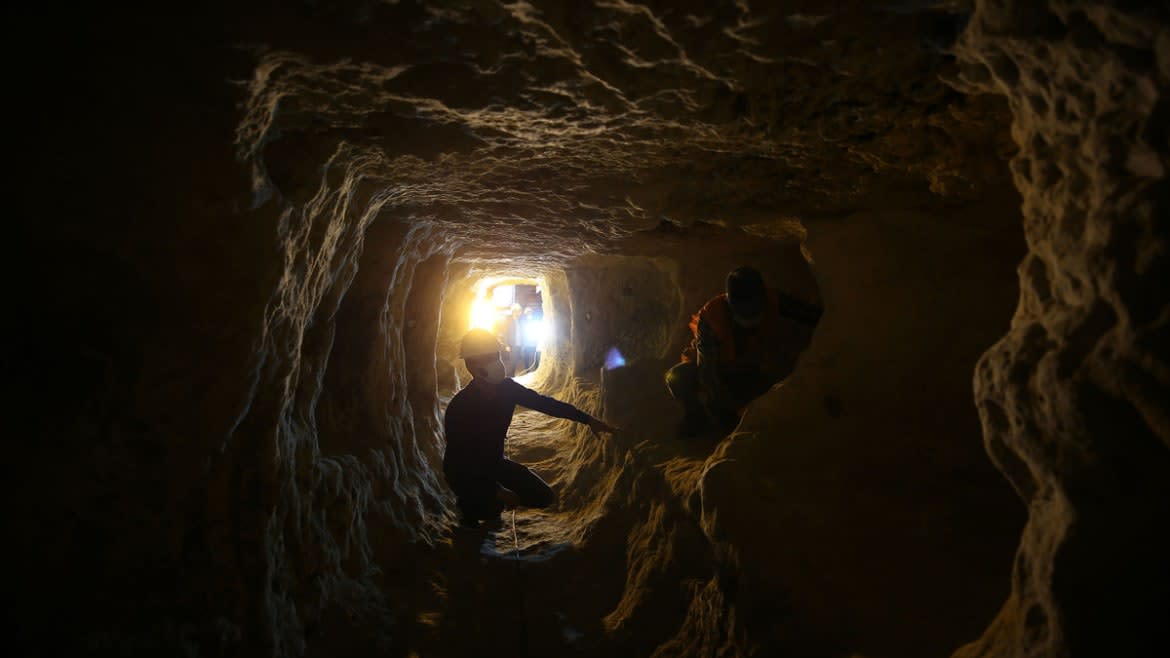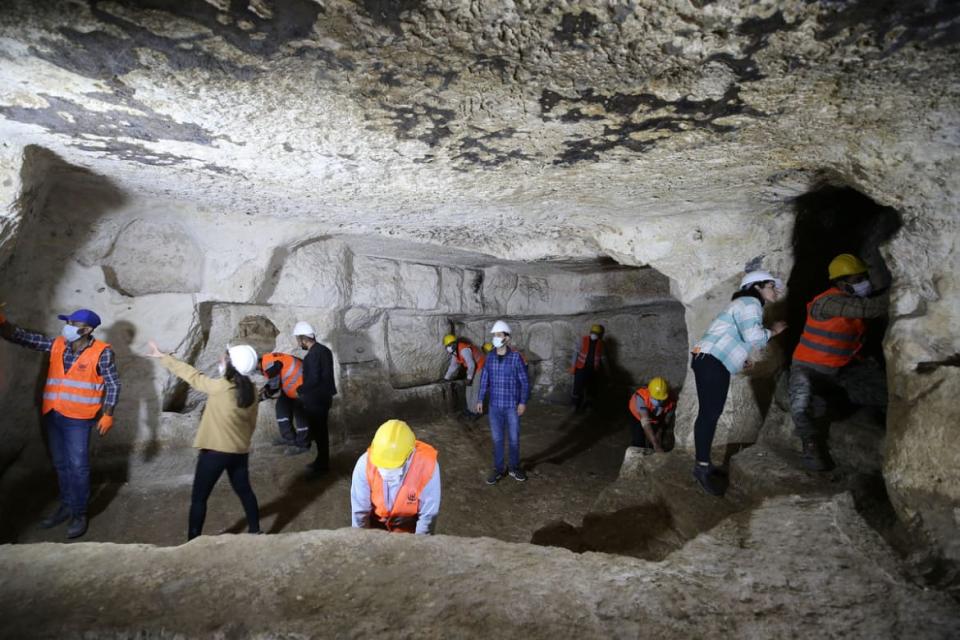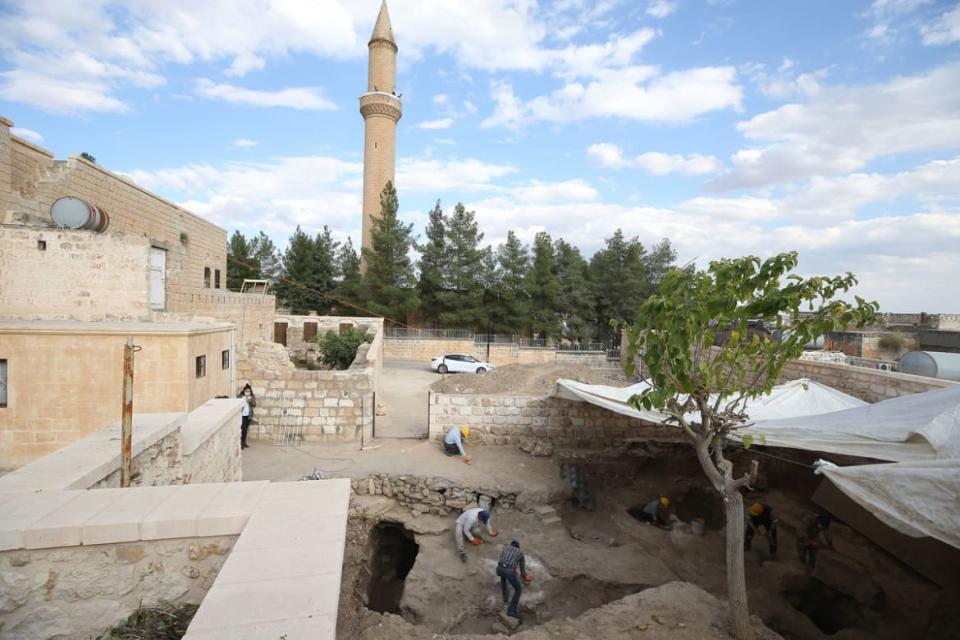Turkey’s Ancient Underground City Isn’t What Everybody Says It Is

Archeologists in Turkey have discovered an almost 2000-year-old underground city in the southeastern province of Mardin. The subterranean complex in modern Midyat was unearthed two years ago, when restorations to the basement level of stone houses revealed a cave that opened to an underground tunnel. The discovery is making headlines as a site of “refuge for early Christians” during periods of persecution by the Romans. But is this true? Did Roman authorities force first century Christians, quite literally, underground? Or is the truth even more interesting?
Even before archeologists unearthed the site, the presence of subterranean tunnels was well known to locals. Underground cities are comparatively common in Turkey, with some estimates of their number running into the hundreds. The most startling part of the recent discovery in Midyat is the sheer scale of the complex: it covers roughly 74 acres (3.2 million square feet). Gani Tarkan, director of the Mardin Museum, who was involved in the initial discovery, told the media that between 50,000 and 70,000 people may have lived there. This would make it, experts say, the largest underground city in Turkey. Thus far, only about 5 percent of the metropolis has been examined.
Like the underground city of Derinkuyu, the subterranean complex was not a mere shelter; it had infrastructure. Among the discoveries were silos for grain storage, food, olive oil, and wine. In addition to the expected human and animal remains, the excavation has also unearthed evidence of wine, coin, and lamp making technologies. Scientists believe that one area, which is decorated with a Star of David, may once have served as an ancient synagogue. Similarly, areas of the Derinkuyu city have been identified as stables, religious spaces, and even a school.
News reports about the discovery, however, lead with the idea that these subterranean cities were built to shelter Christians during periods of persecution. The Wall Street Journal states that, “During the first century, the Roman Empire persecuted Christians and Jews, driving many into hiding.” Similarly, Livescience leads with the idea that “The subterranean complex may have been a protected space that early Christians used to escape Roman persecution.”
The impetus for this interpretation comes from Tarkan himself, who said in comments to Livescience and the Wall Street Journal, that “families and groups who accepted Christianity generally took shelter in underground cities to escape persecution.” Smithsonian added that, “after the persecution ended, these Christians and Jews moved above ground.”
So far, and unlike the city of Derinkuyu, no archeological evidence for the Christian occupation of the underground city in Midyat during the first or second century A.D. has been announced. Thus, nothing about the discoveries so far suggests early Christian occupation, much less hiding. In fact, it’s difficult to imagine what’s so “secretive” about being in an underground city that housed thousands of people.

Excavation teams work as many artifacts from the second and third centuries AD were unearthed in an underground city in Mardin's Midyat district, Turkiye on April 16, 2022
The idea that Christians went underground, therefore, comes from somewhere else entirely. It draws upon a broader and more widely held mythology about early Christians: that during periods of persecution by the Romans, Christians hid in the warren-like catacombs beneath the Eternal City.
According to numerous Christian books, movies, and even Pope Francis, Christians used to retreat to the catacombs to hide from the Roman authorities. The problem with this idea is that it’s a 19th century tourist myth. When the Roman catacombs were excavated during this period, the discovery of utensils and plates led some to conclude that Christians had been forced into subterranean hiding. More recent archeological analysis holds that Christians were holding celebratory, potentially sacramental meals there in honor of the dead. But because of this initial misinterpretation, the catacombs were reshaped as pilgrimage sites and folded into the Grand Tour of Europe. The idea trickled up into the literature of the period: Rome-based 19th century missionary Dr. Wolfred Cote wrote in his 1876 Archaeology of Baptism, “During the dark days of imperial persecutions the primitive Christians of Rome found a ready refuge in the Catacombs.” Somewhat alarmingly Cote’s statement is still cited in some modern Christian books today.
Among scholars, however, the idea is dismissed out of hand. As Prof. Leonard Rutgers of Utrecht University writes, “Researchers have long debunked the myth that Christians used the catacombs as hiding places in times of persecution.” The Encyclopedia of Catholicism agrees noting that in contrast with “novel and movie lore” the catacombs “were not used as hiding places for Christians.” (Full disclosure: I wrote a whole book about the exaggerated mythology of early Christian persecution).
For early Christians, subterranean cities didn’t make excellent secret hideouts. They could (as they would later) serve as places of fortified protection during invasions and attacks by foreigners. But if one’s problem was evading local authorities wouldn’t a better strategy have just been to leave town for a less densely populated region? As Dr. Jennifer Barry traces in her book Bishops in Flight, leaving town in times of political pressure was the most popular option for high-profile affluent ancient Christians. Neither the catacombs of Rome nor the underground cities of Turkey were secret compartments in an anonymous basement; people knew about them. How secret is a hiding place shared by thousands of others?
Oddly, and despite the fact that there are so many of them, some other Turkish subterranean cites are also advertised as Christian refuge sites. Take, for example, the most famous example, Derinkuyu. One respectable history outlet writes that this UNESCO site was “built by early Christians.” (Note: UNESCO makes no such claims on its website). But the so-called ‘persecuted early church’ slips between the cracks of Derinkuyu’s architectural history: the site was founded in the eighth to seventh centuries B.C. by the Phrygians, but was greatly expanded and flourished during the Byzantine period. There were, obviously, no Christians in the seventh century B.C. and Christians were the powerful majority during the Byzantine period. It’s not at all clear if early Christians ever hid from the local Roman authorities underground but they certainly did not build the city for that purpose.

Excavation teams discovered that a cave, which was found during works carried out in the historical streets and houses in the district two years ago, was not the only one, and that there were corridors within the cave which provide passages to different places. The underground city, which is called "Matiate," is home to many places of worship, silos, water wells as well as passages and corridors.
But if the “underground cities” aren’t hideouts for persecuted Christians or even just plain old inhabitants, then what are they?
We can think of some reasons, both practical and impractical, why people built subterranean dwelling places. The lack of escape and cool temperatures make “basements” excellent prisons and storage areas. It’s easier to control people’s movement when their only way out is up. Subterranean hideouts can also be effective shelters during disasters and foreign invasion. But there are also human and cultural elements at work here.
In Turkey, this may be a question of cultural practices that exploit the soft limestone underfoot. In his book Underground: A Human History of the Worlds Beneath Our Feet, journalist Will Hunt recalls talking to an elderly farmer called Latif in the Turkish village of Özkonak. Latif had discovered his own underground city in the early 1970s. “The underground cities are not so strange,” Latif told Hunt “They are everywhere. To dig these spaces is a very old matter. It is a natural thing to do.”
The idea of hiding underground makes practical sense to us because of the military technology has emerged over the past two hundred years. Today, we build bomb shelters underground. Since warfare took to the skies, hiding in subway stations has been a way that besieged World War II Londoners and contemporary Ukrainians avoided airstrikes. Beijing’s Dixia Cheng, a complicated network of tunnels built in the 1970s, was built as a shelter during bombings or nuclear attacks.
Digging also makes emotional sense. Even before air raids, people have dug down to escape attack. And even without a specific reason to fear an attack from the skies, people still do it today. In a move reminiscent of the Cold War bunker-frenzy, a former Soviet bunker in Germany has been converted into luxury Doomsday pads for billionaires. At the start of the pandemic, wealthy Americans set their sights on new construction bunkers in New Zealand. Long after we cease hiding from the world under blankets as children, the urge to burrow into the earth stays with us.
As Hunt explains in his book, though, the appeal of burrowing does not only reside in the cave’s protective appeal. While for many of us tunneling requires that we first wrestle any preservatory claustrophobic impulses to the (under)ground, for others it is a relaxing return to our proverbial and, perhaps, evolutionary roots. We used to be quite comfortable in caves. One of the world’s first burial sites, the Dinaledi chamber in South Africa (236,000-335,000 years old), was an underground chamber in which members of the genus Homo naledi deposited dead. As Prof. Agustin Fuentes writes in his remarkable book Why We Believe, the members of the genus Homo naledi “risked much” to do this: They were small, but to access the chamber they had to first drag the bodies 100 feet through a narrow underground tunnel.
Modern history is full of stories of amateur excavators who find tunneling calming. Take, for example, William Cavendish-Scott-Bentinck, the fifth Duke of Portland, who excavated a metropolis underneath Welbeck Abbey, his family’s Nottinghamshire estate, in the 19th century. With the assistance of paid workers, he equipped it with all the basics: a billiard room, an underground ballroom, and, of course, a roller-skating rink. Or consider, more recently, Elton Macdonald, the Canadian man turned folk hero who built a mysterious, structurally sound tunnel underneath his local park. In 2015, the tunnel sparked panic in Toronto when police identified it as a potential terrorist lair. When Macdonald came forward to alleviate public concerns he could only explain his actions by saying, “Digging relaxes me.”
Get the Daily Beast's biggest scoops and scandals delivered right to your inbox. Sign up now.
Stay informed and gain unlimited access to the Daily Beast's unmatched reporting. Subscribe now.

